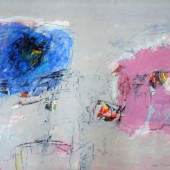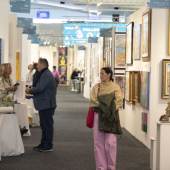Signac, Caillebotte, Monet & More Lead Sotheby's Impressionist & Modern Art Evening Sale
-
Auktion12.11.2019
Executed in 1950, the plaster medium of Quatre figurines (estimate $3/4 million) served Giacometti twice over: one purpose was completely practical in the artist’s process, used (most frequently by his brother Diego) to create the first cast of a clay work. These plaster casts would then be used to create molds for the subsequent bronzes. The other usage was completely artistic and from here the present work derives. These two media allowed him the greatest expression with texture and surface work, where each marking is visible. Once he finished molding and shaping a work in plaster, the artist would often paint the surface to further formalize and refine the piece. In Quatre figurines Giacometti uses a brush to add highlights on the faces where each figure’s eyes stare out, and to delineate right leg from left leg, as well as arms from torso.
Other works by Giacometti include Buste d’homme (Diego au blouson) – a robust personification of the Existentialist movement during the heated years of the Cold War and the most formally radical, visually engaging and emotionally impactful of all his representations of the human figure (estimate $6/8 million).
In addition, Auguste Rodin’s Cariatide tombée portant sa pierre, agrandissement d'un tiers further highlights the outstanding selection of sculpture (estimate $4/6 million). On offer from the Ruthmere Museum in Elkhart, Indiana, the present work was commissioned from the artist by collector Berthe Dumon, who became entranced by a plaster form of the work during a visit to Rodin’s house in February 1894. The work remained with Mme Dumon and her descendants from its creation until 1950. In 1969, the stone was acquired by Walter R. Beardsley of Elkhart, Indiana and subsequently donated by him to the Ruthmere Museum where his son, the Founding Director Robert B. Beardsley, curated its display.
Conceived circa 1881-82 and carved in 1893-94, Cariatide tombée portant sa pierre was viewed by Rodin and his circle as one his most accomplished and important sculptures. Examples of Rodin's Caryatids can today be found in preeminent museum collections around the globe, though the rarity of carved stone is notable. It is thought there may have been a first stone version, whose location is unknown. Two other examples were carved in stone, the present work of 1894 and another carved before 1897, which entered the collection of the Musée Royaux des Beaux-Arts, Brussels in 1918.
A RARE EXAMPLE OF TAMARA DE LEMPICKA’S FULL-LENGTH FIGURES
Depicting one of Tamara de Lempicka’s most famed muses and lovers, Rafaëla, La Tunique rose from 1927 presents a rare example of the artist’s full-length figures (estimate $6/8 million).
An alluring representation of Lempicka’s multifaceted work, La Tunique rose presents a rich tableau balanced by piercing lines and sumptuous curves, her radiant figure accentuated by dramatic chiaroscuro and the pop of silky color against swells of sensuous skin. Beyond her fastidious attention to line and composition, Lempicka possessed a talent for portraying women in a sexualized yet empowering way. The artist’s appreciation of the female form and its power also recalls the once-scandalous nudes of Modigliani, whose works presented women in full possession of their sexuality, often with knowing and solicitous gazes that shocked audiences and authorities at the time.
HENRI DE TOULOUSE-LAUTREC’S VISION OF CYCLING,
RECENTLY ON LOAN TO THE METROPOLITAN MUSEUM OF ART FOR A DECADE
On loan to The Metropolitan Museum of Art for the last decade, Tristan Bernard au Vélodrome Buffalo is an exquisite example of Henri de Toulouse-Lautrec’s insightful Parisian scenes and captures a crucial moment in the history of French Modernism (estimate $4/6 million). Painted in 1895, the present work situates the eponymous Tristan Bernard at the helm of the cycling track which he operated from 1892. Bernard first introduced Lautrec to the world of cycling, though the artist was less interested in the sporting aspect than he was in capturing the spirit of the crowd and movement of the riders. Among his myriad careers as a lawyer, journalist and industrialist, Bernard was perhaps most gratified by his role as director during the triumphant early days of cycling in Paris.
The canvas bears all of the hallmarks of Lautrec’s most defining works: radical touches of color and energetic brushwork; the attuned psychological nuances of his subjects as attested by Bernard’s fast gaze and self-assured posture; and the artist’s quintessential encapsulation of the precise time and place in which the work was created. Once in the collection of Bernard himself, the work comes to market for the first time in more than 70 years from an illustrious family collection.
A QUINTESSENTIAL EXAMPLE OF VILHELM HAMMERSHØI’S DEFINING MOTIFE
A quintessential example of Vilhelm Hammershøi’s defining motif, Interiør, Strandgade 30 from 1899 exemplifies the most refined and important period of Hammershøi’s career (estimate $2.5/3.5 million). On offer from the distinguished collection of Ambassador John L. Loeb, Jr., the work was painted during the years of Hammershøi’s residence at Strandgade 30 in Copenhagen’s historic Christianshavn neighborhood. The artist and his wife Ida moved to Strandgade in 1898 following an extended stay in London, and remained in the same apartment for a decade. It was in these rooms that Hammershøi would complete his best works, including the present canvas.
-
20.04.2022ARTEXPO NEW YORK CELEBRATES ITS 45TH ANNUAL EDITION WITH A RENAISSANCE IN CONTEMPORARY AND FINE...
-
12.04.2021 - 14.04.2021By Pak • 12- 14 April • A novel collection of digital art redefining our understanding...
-
23.05.2018NEW YORK, 16 May 2018 – Today, Sotheby’s is honored to unveil the full contents of A...
-
Art Miami wraps up its 21st edition with record sales and attendance (download this press release...
-
Der Kunstmarkt der vergangenen Jahre war von einem steigenden Interesse an Werken...
-
12.11.2019Auktion »
AUCTION IN NEW YORK ON 12 NOVEMBER
**Media Preview 1 November 2019**
Cameras Welcome as of 8:00AM
Specialist Walkthrough at 9:00AM





















